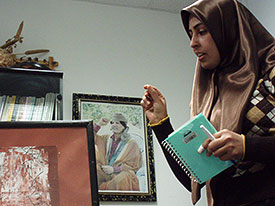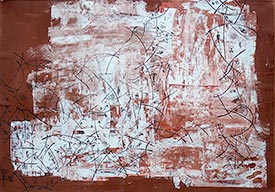
What Women See but Are not Meant to Hear – Khadija Elferjani: Signs and Languages

Khadija Elferjani
Born in 1975, lives and works in Tripolis.
Born in 1975, lives and works in Tripolis.

Expression of a state of relaxation, 2005
Gouache on paper, 35 x 49 cm
Gouache on paper, 35 x 49 cm
A 33-year-old woman shows us her pictures. She has finished her training in 1999 and works in a tiny room at home. She doggedly catches on. Khadija Elferjani could not show her works anywhere but that will definitely come.
To be active artistically in Libya isn’t all that common. For a woman it’s even less the case though there are indications that things are about to change. In Tripolis there are the Art School Zawiat Dahmani and the Academy of Graduate Studies. While students of the Academy study to receive a degree in the end, at Art School the practical training is the centre of attention. During the semester young teacher Mufida Abuajila Kriem teaches three hours per day. It’s predominantly women signing up for her courses, men only insignificantly do so. The ratio is about 90:10 percent. At the end of the training there’s not necessarily an artistic career, but rather an activity in the field of graphic art, for instance.
In a surprising and impressing way Khadija Elferjani combines elements of her culture, women’s concerns and African motifs to become a colorfully shining and symbolically manifold work. Libyan artist Ali Ezouik defines three influences in her work: script (important in Islam), the way women paint themselves in the Orient and, third, elements from people’s life like amulets or glazed tiles in houses, without lapsing into folkloristic art, however, not even allusively. Everything is translated into a painterly expression in an inspired way. Motifs of rock art emerge and are being received like a sign language; the wheel is a sign for desert graves; astrological ideas occur. Lines in her pictures that could (and should) remind one of astrological signs represent, for Khadija Elferjani, connecting lines and family connections existing among families, clans and tribes and with that, in an overriding sense, the ties holding together life. Strong colors with an emotional effect dominate: green, red, brown being associated with the African Continent. Yellow announces the power of light.
Time and time again one encounters picture elements pointing out the traditional Libyan quarters, in Ghadames, for instance. In one of her works she’s been explaining to us in detail one can discern the outlines of a face. From the ears locks are pending. It is locks on the doors of traditional apartments. With this motif of locks Khadija Elferjani wants to point out, expressively and in an associative language, the status of women in the Libyan male-dominated society, and show that there are things “women are not meant to hear”.
Khadija Elferjani has been influenced by Libyan writer Ibrahim al-Koni, among others, which focus on the life and thinking of the Tuareg.
She digests all these influences and combines them to a work which is designed, pleasantly, to a high degree and at the same time artistically in a singular way. It differs considerably from art on the international art markets but keeps its so much more self-conscious and very individual attitude.